Recent memoirs on the Cetacea pl. 2
Fig. 1. The forty-seven and a half feet long Greenland whale skeleton, seen from the side, forty-eight times diminished. (The three anterior caudal vertebrae, the carpus, and the postei'ior extremities, are represented from the forty-four and a half feet long skeleton ; the caudal vertebrae have been bi'ought somewhat nearer to one another than in their fresh state by the drying up of the intervertebral cartilages ; the tail is, therefore, on the whole, somewhat too short.) In the cranium, the letters have the following significations :
b. The left parietal.
f. The left frontal.
i. The left interma-xillary.
k. The right condyle of the occipital.
l. The left lachrymal.
m. The left superior maxillary.
o. The squamous portion of the occipital.
t. The left temporal.
z. The left zygomatic.
Fig. 2. The head of the same forty-seven and a half feet long Greenland whale skeleton, seen from behind, twenty times reduced. The different letters have the following significations:
a. The posterior surface of the articular process of the temporal.
f. The posterior angle of the extremity of the orbital process of the frontal.
g. The tympanic.
i. Superiorly, that part of the free margin of the nasal opening which is formed by the inter-maxillaries ; inferiorly, the free pointed end of the upper jaw formed by the intermaxillaries alone.
k. The condyle of the occipital.
m. Superiorly, the part of the superior maxillary situated immediately around the nasal opening ; inferiorly, the lateral surfaces of the palate, formed by the superior maxillaries and descending obliquely towards the mesial line.
n. The posterior wall of the nasal opening formed by the nasal bones.
o. The external free surface of the occipital.
t'. The part of the temporal meeting the zygomatic arch.
u. The pterygoid cavity situated outside the nasal canals.
v. The posterior end of the vomer.
w. The petrous bone.
Fig. 3. The cervical region and the anterior part of the dorsal region, with the two foremost pairs of ribs, and the sternum of the twenty-two and one third feet long skeleton, all still remaining in their natural connection. From a photograph, about ten times reduced.
1, 2, 3, 4, 5, 6, 7. The bodies of the seven ankylosed cervical vertebræ. ,2. The right inferior transverse process of the second cervical vertebra. ,6. The right inferior transverse process of the sixthcervical vertebra 2,. The left „ „ second
3,. third
1' first ,,
2' second „
1, 2, 3, 4. The bodies of the four anterior dorsal vertebræ.
'2, '3, '4. The right transverse processes of the second, third, and fourth dorsal vertebrae.
1', 2', 3', 5'. The left transverse processes of the first, second, third, and fifth dorsal vertebræ.
c and c'. The angle of the two anterior left ribs (angulus costæ).
t. The place in the second rib corresponding with its tubercle, being that to which the ligaments are affixed which connect it with the transverse process of the second dorsal vertebra.
Fig. 4. The left posterior limb of the forty-four and a half feet long Greenland whale skeleton, six times diminished.
a — d . The pelvic bone.
h. The first subsidiary bone, corresponding with the femur. e. The second and smaller subsidiary bone.
1'. „ superior
2'.Relevantní obrázky


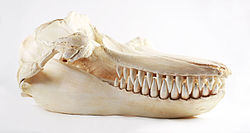










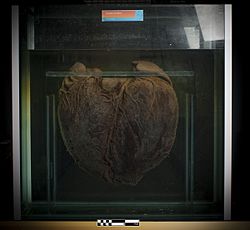

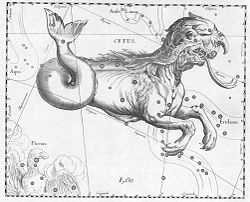






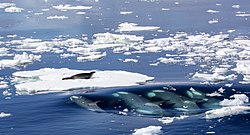


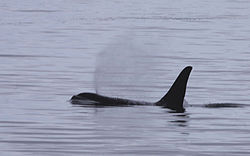



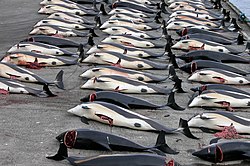









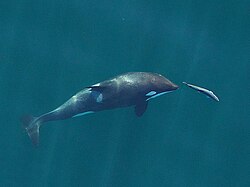


Relevantní články
KytovciKytovci (Cetacea) jsou podskupina (infrařád) sudokopytníků přizpůsobených k životu v moři. Jejich sesterskou skupinou jsou hrochovití. Kvůli výrazným anatomickým a fyziologickým adaptacím na vodní způsob života je jejich evoluční souvislost se suchozemskými savci dosti zastřená a donedávna byli považováni za samostatný řád. Mezi jejich nejnápadnější znaky související s přechodem do vody patří přeměna předních končetin v ploutve a vymizení zadních končetin, vznik horizontální (vodorovné) ocasní ploutve, která je hlavním orgánem pohybu, ztráta srsti, ztráta vnějšího ucha, získání hydrodynamického vřetenovitého tvaru těla a další. Typicky savčím projevem je jejich potřeba dýchat vzduch. Někteří kytovci sice mohou pod vodou vydržet i přes dvě hodiny, ale nakonec se nadechnout musí. Nozdry jsou posunuty v podstatě na temeno hlavy, lebka je touto tzv. teleskopizací oproti lebce jiných savců silně modifikovaná. .. pokračovat ve čtení
